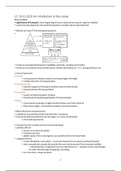College aantekeningen
Aantekeningen Transport Geography - tentamen 1
- Instelling
- Universiteit Utrecht (UU)
Complete en duidelijke aantekeningen van alle colleges van het vak Transport Geography. Bevat ook informatie/samenvatting van alle artikelen die gelezen moeten worden per college (dikgedrukt aangegeven met auteur en jaartal). Heb zelf een 8,7 voor dit tentamen gehaald door alleen dit document te le...
[Meer zien]




